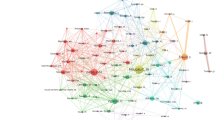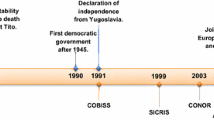Abstract
Contemporary research on Roma from diverse disciplines has grown strongly during the last years. This is the first bibliometric study on the field of Romani studies considering the period 1997–2018 with the aims of mapping scholar’s disciplines and analyzing localization and their thematic contributions. The world evolution of Roma research topics and their citation impacts has been analyzed using a Network Analysis approach. The Scopus database was used to retrieve bibliographic records on Gypsy and Roma research. The bibliometric analysis of scholarly endeavour identifies three principal clusters: ‘History and Culture’, ‘Education’, and ‘Discrimination and Policy’. Results shows that scholars became more attentive to Roma issues as it became an important topic in public debate. Informed by this analysis, questions are raised about how to strengthen connectivity, collaborative research and knowledge exchange beyond national and disciplinary borders. In the term citation map among the most followed themes by number of normalized average quotations, the topics of ‘Discrimination and Policy’ analysis undeniably emerges. In the current historical moment characterised by rising ethno-nationalism and racism we intend that this paper informs further research that will deepen our understanding of the contributions of different social science disciplines with regards to epistemology, methodology and impact.






Similar content being viewed by others
Notes
“The term “Roma” is used – similarly to other political documents of the European Parliament and the European Council – as an umbrella which includes groups of people who have more or less similar cultural characteristics, such as Sinti, Travellers, Kalé, Gens du voyage, etc. whether sedentary or not; around 80% of Roma are estimated to be sedentary (SEC(2010)400)”. Brussels, COM(2011) 173/4. EU Framework for National Roma Integration Strategies up to 2020.
“Council of Europe Descriptive Glossary of terms relating to Roma issues” - version dated 18 May 2012.
It should be noted in some countries the term “Gypsy” has no negative connotations and could be occasionally more appropriate (as the word “Tsigane” in France).
The Alliance against Antigypsyism (2016, p. 6) highlights: “The term antigypsyism—in citing the majority’s projections of an imagined out-group of ‘gypsies’ which simultaneously constructs an imagined in-group—is analytically more accurate and makes clear that other groups—Sinti, Travellers, Manouches, Egyptians—are equally affected”.
The authors collected a first database with the keyword of Traveller as well as Gypsy and Roma. However, as it was not suitable with the purpose of the NA, this larger database was collected and used for the analysis.
The second thematic report of the UN Special Rapporteur on contemporary forms of racism, racial discrimination, xenophobia and related intolerance mapped how resurgent ethno-nationalist populism undermines racial equality globally https://www.ohchr.org/EN/Issues/Racism/SRRacism/Pages/ReportsAG.aspx. The European network of equality bodies, Equinet, and the National Office against Racism recognized the rise of populism and nationalism and the associated risks to equality, by co-organizing a seminar to strategize on this challenge, which informed the publication ‘Not on Our Watch! Developing Strategies to Combat Hate Speech. A Guide for National Equality Bodies’, which was co-funded by the Rights, Equality and Citizenship Programme of the European Union http://www.equineteurope.org/IMG/pdf/final_developing_strategies_to_combat_hate_speech.pdf.
Considering the total amount of the estimated Roma attendance in Europe, U.K. is at the 11th (source: Council of Europe, 2012. Turkey, Russia and Serbia are included); the average estimate as a % of total population is 0.36%.
References
Acton, T. A. (2016). Scientific racism, popular racism and the discourse of the Gypsy Lore Society. Ethnic and Racial Studies,39(7), 1187–1204. https://doi.org/10.1080/01419870.2015.1105988.
Alliance against Antigypsyism (2016). Antigypsyism. A reference paper. Retrieved January 20, 2020, from www.antigypsyism.eu.
Blei, D. M., Ng, A. Y., & Jordan, M. I. (2003). Latent Dirichlet allocation. Journal of Machine Learning Research,3(1), 993–1022.
Bobakova, D., Dankulincova Veselska, Z., Babinska, I., Klein, D., Madarasova Geckova, A., & Cislakova, L. (2015). Differences between Roma and non-Roma in how social support from family and friends helps to overcome health care accessibility problems. International Journal for Equity in Health,14(1), 37.
Bogdan, M., Dunajeva, J., Junghaus, T., Kóczé, A., Rostas, I., Rövid, M., et al. (2018). Introducing the new journal critical Romani studies. Critical Romani Studies,1(1), 2–7. https://doi.org/10.29098/crs.v1i1.19.
Bruggeman, J., Traag, V. A., & Uitermark, J. (2012). Detecting communities through network data. American Sociological Review,77(6), 1050–1063.
Cobo, M., López-Herrera, A., Herrera-Viedma, E., & Herrera, F. (2011). Science mapping software tools: Review, analysis, and cooperative study among tools. Journal of the American Society for Information Science and Technology,62(7), 1382–1402. https://doi.org/10.1002/asi.21525.
Costa, C., Schurr, U., Loreto, F., Menesatti, P., & Carpentier, S. (2019). Plant phenotyping research trends, a science mapping approach. Frontiers in Plant Science,9, 1933.
Földes, M. E., & Covaci, A. (2012). Research on Roma health and access to healthcare: State of the art and future challenges. International Journal of Public Health,57(1), 37–39.
Hamilton, C. A., Vacca, R., & Stacciarini, J.-M. R. (2017). The emergence of team science: Understanding the state of adoption research through social network analysis. Adoption & Fostering,41(4), 369–390. https://doi.org/10.1177/0308575917714714.
Heaslip, V., Hean, S., & Parker, J. (2016). Lived experience of vulnerability from a Gypsy Roma traveller perspective. Journal of Clinical Nursing,25(13–14), 1987–1998.
Jacquot, S., & Vitale, T. (2014). Law as weapon of the weak? A comparative analysis of legal mobilization by Roma and Women’s groups at the European level. Journal of European Public Policy,21(4), 587–604.
Kóczé, A., & Rövid, M. (2017). Roma and the politics of double discourse in contemporary Europe. Identities,24(6), 684–700. https://doi.org/10.1080/1070289X.2017.1380338.
Larsen, P. O., & von Ins, M. (2010). The rate of growth in scientific publication and the decline in coverage provided by Science Citation Index. Scientometrics,84(3), 575–603.
Liégeois, J. P. (2012). The Council of Europe and Roma: 40 years of action. Strasbourg: Council of Europe.
Lloyd, S. (1982). Least squares quantization in PCM. IEEE Transactions on Information Theory,28(2), 129–137. https://doi.org/10.1109/TIT.1982.1056489.
Matras, Y., & Leggio, D. V. (Eds.). (2018). Open borders, unlocked cultures Romanian Roma migrants in Western Europe. London and New York: Routledge.
Mayer, N., Michelat, G., Tiberj, V., & Vitale, T. (2019). L’hostilité envers les Roms. La lutte contre le racisme, l’antisémitisme et la xénophobie. Année 2018. Commission nationale consultative des droits de l’homme. Paris: La Documentation française.
McGarry, A. (2017). Romaphobia. The last acceptable form of racism. Zed Books: London.
Nardi, P., Di Matteo, G., Palahi, M., & Scarascia Mugnozza, G. (2016). Structure and evolution of mediterranean forest research: a science mapping approach. PLoS ONE,11, e0155016. https://doi.org/10.1371/journal.pone.0155016.
Nedelcu, M., & Ciobanu, R. O. (2016). Les migrations des Roms Roumains en Europe. Revue Européenne des Migrations Internationales,32(1), 7–17.
Newman, M. E. J. (2006). Modularity and community structure in networks. Proceedings of the National Academy of Sciences,103(23), 8577–8582.
Newman, M. E. J., & Girvan, M. (2004). Finding and evaluating community structure in networks. Physical Review E,69(2), 026113. https://doi.org/10.1103/PhysRevE.69.026113.
Powell, R., & Lever, J. (2017). Europe’s perennial ‘outsiders’: A processual approach to Roma stigmatization and ghettoization. Current Sociology,65(5), 680–699. https://doi.org/10.1177/0011392115594213.
Quercia, D., Aiello, L. M., & Schifanella, R. (2018). Diversity of indoor activities and economic development of neighborhoods. PLoS ONE,13(6), e0198441. https://doi.org/10.1371/journal.pone.0198441.
Richardson, J. (2014). Roma in the News: An examination of media and political discourse and what needs to change. People, Place and Policy,8(1), 51–64. https://doi.org/10.3351/ppp.0008.0001.0005.
Schaub, M. T., Delvenne, J. C., Rosvall, M., & Lambiotte, R. (2017). The many facets of community detection in complex networks. Applied Network Science,2(1), 4.
Shwed, U., & Bearman, P. S. (2010). The temporal structure of scientific consensus formation. American Sociological Review,75(6), 817–840. https://doi.org/10.1177/0003122410388488.
Toma, S., & Fosztó, L. (2018). Returnees and their neighbors: Migration of the Romanian Roma, networks, social distance, and local development. Review of Sociology,28(4), 37–60.
Tremlett, A., Messing, V., & Kóczé, A. (2017). Romaphobia and the media: Mechanisms of power and the politics of representations. Identities,24(6), 641–649. https://doi.org/10.1080/1070289X.2017.1380270.
Vacca, R., McCarty, C., Conlon, M., & Nelson, D. R. (2015). Designing a CTSA-based social network intervention to foster cross-disciplinary team science. Clinical and Translational Science,8(4), 281–289.
van Eck, N. J., & Waltman, L. (2010). Software survey: VOSviewer, a computer program for bibliometric mapping. Scientometrics,84, 523–538. https://doi.org/10.1007/s11192-009-0146-3.
van Eck, N. J., & Waltman, L. (2011). Text mining and visualization using VOSviewer. arXiv preprint arXiv:1109.2058.
Van Eck, N. J., & Waltman, L. (2014). Visualizing bibliometric networks. Measuring scholarly impact (pp. 285–320). Cham: Springer.
van Eck, N. J., Waltman, L., van Raan, A. F., Klautz, R. J., & Peul, W. C. (2013). Citation analysis may severely underestimate the impact of clinical research as compared to basic research. PLoS ONE,8, e62395. https://doi.org/10.1371/journal.pone.0062395.
van Raan, A. F. (2014). Advances in bibliometric analysis: Research performance assessment and science mapping. In W. Blockmans, L. Engwall, & D. Weaire (Eds.), Bibliometrics. Use and abuse in the review of research performance (pp. 17–28). Dordrecht: Springer.
Vives-Cases, C., Goicolea, I., Hernández, A., Sanz-Barbero, B., Davó-Blanes, M. C., & La Parra-Casado, D. (2017). Priorities and strategies for improving Roma women’s access to primary health care services in cases on intimate partner violence: A concept mapping study. International Journal of Equity Health,16, 1–10.
Waltman, L., & van Eck, N. J. (2013). A smart local moving algorithm for large-scale modularity-based community detection. European Physics Journal B,86, 471. https://doi.org/10.1140/epjb/e2013-40829-0.
Waltman, L., van Eck, N. J., & Noyons, E. C. M. (2010). A unified approach to mapping and clustering of bibliometric networks. Journal of Informetrics,4, 629–635. https://doi.org/10.1016/j.joi.2010.07.002.
Wuchty, S., Jones, B. F., & Uzzi, B. (2007). The increasing dominance of teams in production of knowledge. Science,316(5827), 1036–1039.
Acknowledgements
Vanessa Ioannoni and Iris Elliott are members of the Equality Data Sub-Group of the European Commission’s High Level Group on Non-Discrimination, Equality and Diversity. Tommaso Vitale is engaged in the French ANR research program MARG-IN (project number ANR-15-CE28-0006): MARGinalisation/INclusion. Mid and long term effects of the policies aiming at managing poverty on target populations: the case of the people called Roma in Western European cities.
Author information
Authors and Affiliations
Corresponding author
Ethics declarations
Conflict of interest
The authors declare that they have no conflict of interest.
Electronic supplementary material
Below is the link to the electronic supplementary material.
Rights and permissions
About this article
Cite this article
Ioannoni, V., Vitale, T., Costa, C. et al. Depicting communities of Romani studies: on the who, when and where of Roma related scientific publications. Scientometrics 122, 1473–1490 (2020). https://doi.org/10.1007/s11192-020-03352-5
Received:
Published:
Issue Date:
DOI: https://doi.org/10.1007/s11192-020-03352-5




